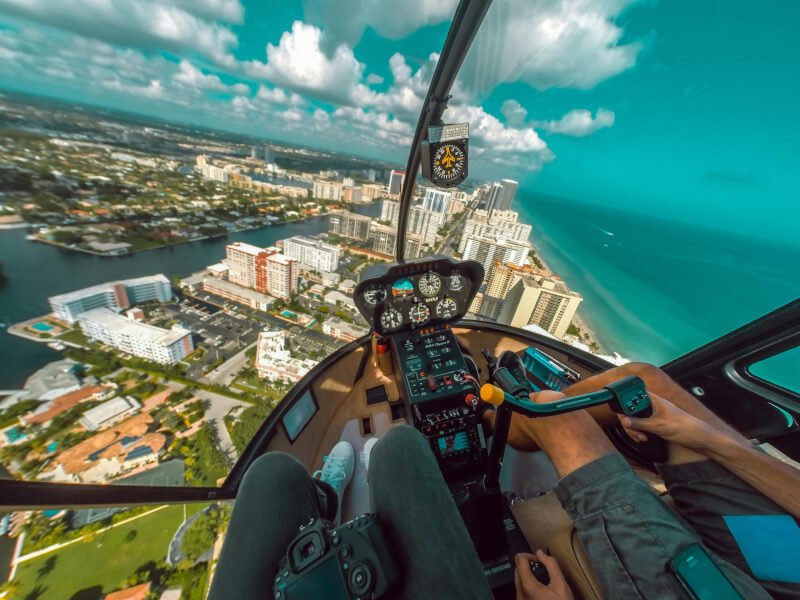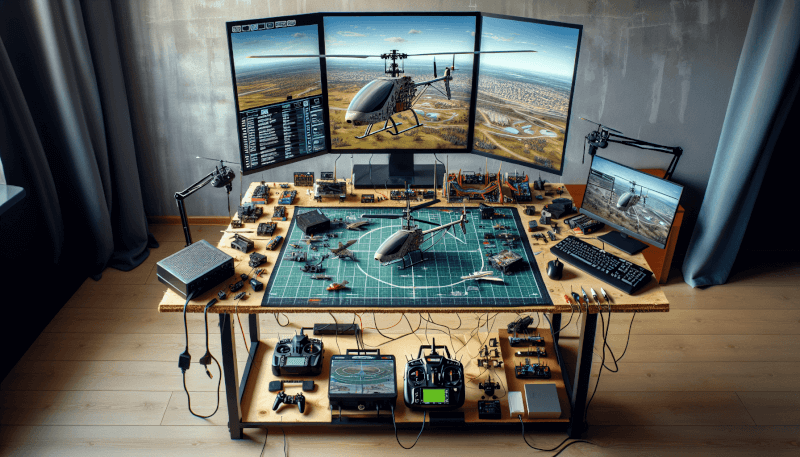Have you ever dreamed of flying a remote control helicopter but hesitated due to the fear of crashing and damaging your expensive toy? Well, worry no more! In this article, you will discover a step-by-step guide on how to build your own RC helicopter simulator right at home. With this simulator, you can practice and master your flying skills without the risk of crashing or breaking anything. Get ready to embark on an exciting journey of creating your very own virtual flight experience, where the sky is the limit and your dreams take flight!

Choosing the Right Software
Researching available options
When it comes to building your own RC helicopter simulator, the first step is to research the available software options. There are various simulators available in the market, each offering different features and functionalities. By conducting thorough research, you can compare the different software options and determine which one suits your needs the best.
Considerations for compatibility with your system
Once you have identified a few potential software options, it is crucial to consider the compatibility with your system. Check the minimum system requirements for each simulator and ensure that your computer can handle the software without any issues. Compatibility issues can lead to performance problems and hinder the overall experience.
Looking for specific features and functions
Another important aspect to consider when choosing the software is the specific features and functions that you require. Different simulators offer varying levels of realism, training capabilities, and customization options. Think about what you value the most in a simulator and make sure that the software you select can meet those requirements.
Selecting the Hardware
Choosing a suitable computer or laptop
To build your RC helicopter simulator, you will need a suitable computer or laptop that can handle the demands of the simulator software. Look for a system with sufficient processing power, RAM, and graphics capabilities. This will ensure that your simulator runs smoothly and provides a realistic experience.
Deciding on a controller or joystick
Next, you will need to decide on a controller or joystick for operating the simulator. Look for a controller that is specifically designed for flight simulation and offers realistic controls. Consider factors such as the number of buttons, ergonomics, and compatibility with the simulator software.
Considerations for additional accessories
Depending on your preferences and budget, you may also consider additional accessories to enhance your simulator experience. Some popular options include rudder pedal systems, throttle quadrants, and virtual reality headsets. These accessories can further immerse you in the simulation and provide a more realistic flying experience.
Creating a Dedicated Space
Allocating a specific area for the simulator
To fully enjoy your RC helicopter simulator, it’s essential to allocate a specific area in your home where you can set up your equipment. Find a space that is quiet, away from distractions, and has enough room to accommodate your computer, controller, and any additional accessories. Having a dedicated space will allow you to fully focus on your simulation sessions.
Setting up a comfortable seating arrangement
Comfort is key when spending long hours on your simulator. Invest in a comfortable chair or seating arrangement that provides proper support for your back and arms. A well-designed seating arrangement will prevent discomfort and fatigue, allowing you to fully enjoy your simulator sessions.
Ensuring proper lighting and ventilation
Good lighting and ventilation are crucial for creating an optimal simulator environment. Make sure the area where you set up your simulator has adequate lighting to avoid straining your eyes. Additionally, ensure proper ventilation to prevent overheating of your computer and to maintain a comfortable temperature in the room.
Setting Up the Simulator Software
Downloading and installing the selected software
Once you have chosen the software for your RC helicopter simulator, it’s time to download and install it on your computer. Visit the official website or authorized resellers to obtain the software and follow the installation instructions provided. Make sure to download the latest version for optimal performance and access to any updates or bug fixes.
Configuring the software settings
After installing the software, take some time to configure the settings according to your preferences. Adjust graphics settings, control sensitivity, and audio settings to create a personalized experience. Most simulators offer a wide range of customization options, allowing you to tailor the simulation to your liking.
Calibrating the controller or joystick
Before you start using your controller or joystick, it is essential to calibrate it properly. This process ensures that the controls are accurately interpreted by the simulator software. Most simulators provide a calibration wizard or tool that guides you through the process. Follow the instructions carefully to ensure the controls respond accurately to your inputs.

Connecting the Hardware
Connecting the controller or joystick to the computer
To connect your controller or joystick to the computer, simply plug it into an available USB port. Most modern controllers are plug-and-play, meaning they will be automatically recognized by the computer. However, some older controllers may require additional driver installation. Refer to the manufacturer’s instructions for specific guidance.
Securing any additional accessories
If you have additional accessories such as rudder pedals or throttle quadrants, make sure they are securely connected to your computer. Follow the manufacturer’s instructions for proper setup and connection. Securing the accessories firmly will prevent any accidental disconnects during your simulator sessions.
Troubleshooting connection issues
If you encounter any connection issues between the hardware and the computer, there are a few steps you can take to troubleshoot. First, ensure that all cables are securely connected. Restart your computer and check for any driver updates or software patches that may address connection problems. If the issue persists, reach out to the customer support of the hardware manufacturer for further assistance.
Preparing the Simulator Environment
Adjusting graphical settings for optimal performance
To ensure optimal performance of your RC helicopter simulator, adjust the graphical settings according to your computer’s capabilities. Higher graphics settings may provide a more realistic experience but can also put additional strain on your system. Find a balance that allows for smooth gameplay without sacrificing visual quality.
Customizing the virtual environment
Many simulators offer the option to customize the virtual environment in which you fly your RC helicopter. Take advantage of this feature to create scenarios that suit your preferences. Whether it’s flying through scenic landscapes or practicing maneuvers in challenging terrain, customization allows you to make the simulation truly your own.
Adding realistic physics and flight models
To further enhance the realism of your simulator, consider adding realistic physics and flight models. Some simulators provide the ability to download additional flight models that accurately simulate the behavior and performance of specific RC helicopter models. This can be a valuable tool for practicing and improving your flying skills.

Practicing Basic Controls
Learn the functions of the different controls
Before taking your RC helicopter to the virtual skies, take the time to familiarize yourself with the functions of the different controls. Understand how the throttle, cyclic, collective, and tail rotor controls affect the helicopter’s movement. Knowing the functions of each control will make it easier to navigate and perform maneuvers during your simulator sessions.
Practice basic maneuvers and flight patterns
Once you have familiarized yourself with the basic controls, it’s time to practice various maneuvers and flight patterns. Start with simple exercises such as hovering, forward flight, and turns. Gradually progress to more advanced maneuvers like loops, rolls, and inverted flight. Regular practice of these maneuvers will help improve your piloting skills and confidence.
Mastering takeoff and landing techniques
Takeoffs and landings are critical aspects of helicopter flying. Spend ample time practicing these techniques in your simulator. Mastering smooth takeoffs and landings will not only make your flights look more realistic but also improve your overall control and precision. Focus on maintaining a steady hover during takeoff and landing to avoid any abrupt movements.
Exploring Different Scenarios
Trying out various flying environments
One of the advantages of having your own RC helicopter simulator is the ability to explore different flying environments. Take advantage of the simulator’s capabilities and try flying in various settings, such as urban landscapes, rural areas, or even challenging terrains. Each environment presents unique challenges and opportunities for honing your piloting skills.
Experimenting with different weather conditions
Simulating different weather conditions can provide a more immersive and challenging experience in your RC helicopter simulator. Try flying in various weather conditions, such as rain, wind, or fog, to test your ability to handle adverse conditions. This will help you become a more confident and skilled pilot in real-life scenarios.
Simulating emergency situations for training
An RC helicopter simulator is an excellent tool for practicing emergency procedures without the risks associated with real-life situations. Create scenarios that simulate engine failures, control system malfunctions, or other emergency situations. Regularly practicing these scenarios will help sharpen your decision-making abilities and improve your ability to handle unexpected events.

Expanding Your Simulator Experience
Adding additional RC helicopter models to your simulator
To expand your simulation experience, consider adding additional RC helicopter models to your simulator. Many simulators offer the ability to download or purchase additional models. This allows you to explore different helicopter types, sizes, and designs, providing a more diverse and challenging flying experience.
Installing scenery and objects for a more immersive experience
Enhance the realism of your simulator by installing scenery and objects that mimic real-life flying locations. Many simulators offer the ability to download and install additional scenery packs, which include detailed landscapes, buildings, and landmarks. This will not only make your simulator visually appealing but also create a more immersive flying experience.
Connecting with fellow RC helicopter simulator enthusiasts
Building your own RC helicopter simulator opens up the opportunity to connect with fellow enthusiasts in the RC helicopter community. Join online forums, social media groups, or local clubs to share your experiences, learn from others, and participate in virtual events or competitions. Engaging with like-minded individuals will enrich your simulator journey and provide valuable insights and support.
Safety Precautions
Maintain a safe and clutter-free simulator area
To ensure a safe simulator experience, it is essential to maintain a safe and clutter-free environment. Remove any trip hazards, secure cables and wires, and organize your equipment in a logical and safe manner. This will minimize the risk of accidents or damage to your equipment during your simulator sessions.
Take regular breaks to avoid fatigue
Spending extended periods on your simulator can lead to fatigue and diminished concentration. Take regular breaks during your sessions to stretch, rest your eyes, and recharge. This will not only reduce the risk of physical strain but also allow you to maintain focus and enjoy your simulator experience to the fullest.
Avoid unauthorized modifications or alterations
While it may be tempting to modify or alter your simulator hardware or software, it’s essential to avoid unauthorized modifications. Making unauthorized changes can lead to compatibility issues, performance problems, or even void warranties. Stick to recommended updates and modifications from the manufacturer or authorized sources to ensure a safe and reliable simulator setup.
Building your own RC helicopter simulator at home can be an exciting and rewarding endeavor. By following the steps outlined in this article, you can create a dedicated space, select the right software and hardware, and configure your simulator for optimal performance and enjoyment. Remember to prioritize safety, practice regularly, and have fun exploring the virtual skies with your RC helicopter simulator.



